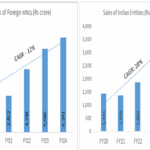Author: Soumita Biswas, Chief Nutritionist, Aster RV Hospital
India
healthysoch
New Delhi, November 29, 2022:


These foods are typically high in fiber and have a low glycemic index. Calories are an important component of food and everything we eat has calories. Calories are of 2 types. One is empty calories which don’t have much nutritive value but just have calories and promotes weight gain. Foods with high fiber and water content usually have fewer calories and we need more energy to digest them, these are called negative calorie foods. These foods help to lose weight as they are not only low in calories but also help to burn out more calories than others. Most negative calorie foods are plant-based.
10 negative calorie foods:
Celery: It contains 16 kcal/100g.It is rich in fiber, vitamin A, C and Folate. It is one of the most popular negative food items as most of its calorie value is stored in cellulose. Our body receives very few calories from celery as it is full of undigested fiber.
Berries: Colorful berries such as blueberries, strawberries, raspberries typically contain just 32 kcal for a half-cup quantity. Berries are called negative calorie foods because of their low glycemic index & their protein content. It also contains antioxidants, which protects us from various cancers.
Tomatoes: It has 19kcal/100g. Apart from its water content, it is an excellent source of fiber, potassium and vitamin C. Tomatoes also contain lycopene, an antioxidant known to protect us from skin cancer.
Carrots: They contain 41 kcal/100g. Its vitamin A content is good for the eyes. Carrot fiber content keeps the stomach full for a longer time thus helps in weight loss.
Cucumber: It contains 15 kcal/100g. This vegetable has high water content which is great to satisfy thirst along with providing all the necessary vitamins and minerals. The water content present in cucumbers is great for hydration. Along with quenching thirst, this fruit provides dietary fiber and is good for irritable bowel syndrome and diabetic patients.
Watermelon: It has 30 kcal/100g. Some of the benefits of watermelon rind include a healthy heart, provide hydration & regulation of blood pressure. Additionally, watermelon seeds also have many health benefits starting from the prevention of anemia to immune-boosting properties. The water content present in watermelon & vitamins A, B6, C along with lycopene act as an immune-boosting food.
Apple: It provides 52 kcal/100g. Apple contains a good number of antioxidants, vitamin C & fibers. Apple’s high fiber content helps in weight loss & it also helps to boost cognitive performance. Quercetin, an antioxidant present in apples, is also associated with lowering the risk of type 2 Diabetes.
Broccoli: It contains 34 kcal/100g. Its vitamin A content improves vision. Calcium, Phosphorus, vitamin K content is essential for healthy bone development. Iron and folic acid help to prevent anemia. Kaempferol, a flavonoid present in broccoli, has anti-inflammatory properties. Broccoli is also rich in Alpha linolenic acid (ALA)which is crucial for brain growth & development.
Zucchini: It contains about 17 kcal/100g. It is packed with many important vitamins, minerals and antioxidants. This has a high fiber content & a low-calorie count. Fiber plays an important role in digestion. Zeaxanthin, present in Zucchini, plays an important role in preventing oxidative stress & improves eye health.
Lettuce: It provides about 15 kcal/100g. Its vitamin C, Calcium, vitamin K, vitamin A content helps in boosting immunity. The fiber content of lettuce helps in weight loss. It is also associated with a healthy heart and maintaining eye health.
Are there any side effects?
There is no evidence that eating negative calorie foods leads to side effects. However, directly eating low amounts of calories is not advised if you are not under the supervision of a dietician. The calorie requirement to reduce weight is individualized. The requirement varies depending on the person’s height, weight, BMI, BMR, and physical activity.
These foods can be added to our daily diet as snacks or cooking ingredients. Cucumber, tomatoes, carrots and lettuce can be used in various salads. Berries, apple or watermelon fruit can be used as a midmorning or evening snack. broccoli, zucchini or lettuce can be used in various preparations during cooking.
healthysoch








The offer is still valid. Details [Link deleted]
Web Development Wizards [Link deleted]
Can provide a link mass to your website [Link deleted]
Your site’s position in the search results [Link deleted]
Can provide a link mass to your website [Link deleted]
Your site’s position in the search results [Link deleted]
Free analysis of your website [Link deleted]
SEO Optimizers Team [Link deleted]
I really liked your site. Do you mind [Link deleted]
Here’s what I can offer for the near future [Link deleted]
You will definitely like it [Link deleted]
Web Development Wizards [Link deleted]
Can provide a link mass to your website [Link deleted]
Your site’s position in the search results [Link deleted]
Free analysis of your website [Link deleted]
SEO Optimizers Team [Link deleted]
I offer mutually beneficial cooperation [Link deleted]
Cool website. There is a suggestion [Link deleted]
Content for your website [Link deleted]
Web Development Wizards [Link deleted]
Can provide a link mass to your website [Link deleted]
Your site’s position in the search results [Link deleted]
SEO Optimizers Team [Link deleted]
I offer mutually beneficial cooperation [Link deleted]
Cool website. There is a suggestion [Link deleted]
Content for your website [Link deleted]
Web Development Wizards [Link deleted]
Can provide a link mass to your website [Link deleted]
Your site’s position in the search results [Link deleted]
Free analysis of your website [Link deleted]
SEO Optimizers Team [Link deleted]
I offer mutually beneficial cooperation [Link deleted]
Content for your website [Link deleted]
Web Development Wizards [Link deleted]
Can provide a link mass to your website [Link deleted]
Your site’s position in the search results [Link deleted]
Free analysis of your website [Link deleted]
SEO Optimizers Team [Link deleted]
I offer mutually beneficial cooperation [Link deleted]
Cool website. There is a suggestion [Link deleted]
I really liked your site. Do you mind [Link deleted]
You will definitely like it [Link deleted]
The best prices from the best providers [Link deleted]
Additional earnings on your website [Link deleted]
Analytics of your website [Link deleted]
I would like to post an article [Link deleted]
How to contact the administrator on this issue [Link deleted]
Shall we exchange links? My website [Link deleted]
The offer is still valid. Details [Link deleted]
Content for your website [Link deleted]
Web Development Wizards [Link deleted]
Can provide a link mass to your website [Link deleted]
Web Development Wizards [Link deleted]
Your site’s position in the search results [Link deleted]
I offer mutually beneficial cooperation [Link deleted]